It is well understood that hearing loss reduces the audibility of speech and thus impairs communication (Revoile, 1999). It has also been clearly demonstrated that experiencing a hearing loss reduces overall quality of life (Dalton et al., 2003; McArdle, Chisolm, Abrams, Wilson, & Doyle, 2005; Mulrow et al., 1990; Pugh & Crandell, 2002). Hearing loss has been associated with depressive symptoms, feelings of loneliness, and a small social network (Carabellese et al., 1993; Gurland et al., 1977; Kramer, Kapteyn, Kuik, & Deeg, 2002). Additionally, qualitative evidence has demonstrated that hearing loss affects the psychosocial status of the significant other of an individual with hearing loss (Brooks, Hallam, & Mellor,2001; Hetu, Riverin, Lalande, Getty, & St-Cyr, 1988; Hetu, Lalonde, & Getty, 1987; Lormore & Stephens, 1994; Piercy & Piercy, 2002a; Scarinci, Worrall, & Hickson, 2008). While hearing aids improve the quality of life for people with hearing loss (Chisolm et al., 2007) and their significant others (Brooks et al., 2001; Newman, Jacobson, Hug, Weinstein, & Malinoff, 1991; Stark & Hickson, 2004), residual impairments often remain. Group audiologic rehabilitation programs for both people with hearing loss and their significant others can be effective in addressing residual hearing loss related quality of life effects that remain after hearing aid fitting or cochlear implant provision. This article will discuss: 1) the theoretical basis for implementing group audiologic rehabilitation programs for people with hearing loss and their spouses, 2) the effectiveness of these programs, and 3) suggestions for implementing these programs in a clinical practice.
The Theoretical Basis for Implementing Group Audiologic Rehabilitation Programs
People with Hearing Loss
The psychosocial aspects of hearing loss are multidimensional (Hetu, 1996; Hogan, 2001; Trychin, 2002) and may be classified in terms of emotional, cognitive, interpersonal, behavioral and physical reactions to hearing loss (Trychin, 2002). For example, one cognitive reaction is increased effort required for comprehension in difficult listening situations (Pichora-Fuller & Singh, 2006). After prolonged periods of extra effort, individuals may become inattentive or have difficulty concentrating. Since hearing loss can result in stress (Hetu, Jones, & Getty, 1993), physical reactions such as fatigue, muscle tension, headaches, stomach problems, and sleep problems may occur (Trychin, 2002). One emotional reaction to hearing loss is stigma, the shame or disgrace associated with something that is socially unacceptable (Hetu, 1996). As a result of the stigma associated with hearing loss, individuals may isolate themselves, avoid social interactions, and/or bluff their way through communication breakdowns. These behaviors and feelings can result in a change of one's social identity and can result in an enduring sense of social uncertainty (Hetu, 1996; Hogan, 2001).
Participation in group audiologic rehabilitation programs is a straightforward way to address the stigma and loss of social identity associated with hearing loss (Hetu, 1996). In such a group, all members share the stigma of hearing loss; as a result, hearing loss becomes typical rather than deviant. In a supportive group, individuals with hearing loss can share their experiences, feelings, and frustrations. Group leaders can directly address these issues with activities designed to evoke the feelings, behaviors, and physical effects associated with hearing loss (Hogan, 2001).
Social comparison theory (Suls, Matin, & Wheeler, 2002) can be utilized in order to understand the theoretical basis for the benefits of group audiologic rehabilitation. Individuals engage in social comparison when they compare themselves with others in order to evaluate their own reactions, to learn about themselves, or to feel better about themselves (Suls et al.). Social comparison in a rehabilitation group can reassure people with a condition (and their spouses) that they are managing well. Participants may find comfort in the realization that others are living with the same situations and that their reactions are typical rather than aberrant (Stewart, Davidson, Meade, Hirth, & Weld-
Viscount, 2001).
Once individuals begin to accept their hearing loss, they can begin to deal constructively with the communication difficulties that hearing loss may impose. In order to achieve effective communication the individual with hearing loss must first admit to having a hearing loss, and second, must propose solutions (Hogan, 2001; Kaplan, Bally, & Garretson, 1985). Participation in an audiologic rehabilitation group is an ideal forum for teaching communication strategies, the skills to anticipate and/or repair communication difficulties. In a group, participants may have the opportunity to role-play the management of difficult situations in an assertive fashion (Hickson & Worrall, 2003; Hickson, Worrall, & Scarinci, 2007). In a supportive group environment, individuals can share their fears about admitting their hearing loss and they can practice effective communication techniques.
Significant Others
There are a broad range of effects that result from living with a person with hearing loss. Spouses of people with hearing loss have reported behavioral adjustments to ensure successful communication including: the need to repeat what they say, the need to speak more slowly, and the need to make sure they are in the same room with their partner with hearing loss (Hetu et al., 1988; Scarinci et al., 2008). Spouses of people with hearing loss have reported emotional reactions such as anxiety, stress, frustration and embarrassment (Brooks et al., 2001; Hetu et al., 1988; Scarinci et al., 2008). Living with an individual with hearing loss can result in a diminished social life and less satisfaction in the marriage (Piercy & Piercy, 2002b; Scarinci et al., 2008). Successful audiologic rehabilitation improves quality of life for both people with hearing loss as well as their spouses. For example, Newman et al. (1991) demonstrated that discrepancies in hearing loss related quality of life scores between people with hearing loss (PHLs) and their significant others (SOs) were significantly reduced post hearing aid fitting as compared to pre hearing aid fitting. Other studies report improvements in both PHLs and SOs in hearing loss related quality of life posthearing aid fitting (Brooks et al., 2001; Stark et al., 2004). When significant others are involved in the audiologic rehabilitation process, people with hearing loss are more likely to benefit from both their hearing aids (Duijvestijn et al., 2003) and from a group audiologic rehabilitation program (Preminger, 2003). It appears that the inclusion of the significant other in the audiologic rehabilitation process improves outcomes for both the person with hearing loss and for the significant other.
Effectiveness of Group Audiologic Rehabilitation
Evaluation Tools
Before discussing the effectiveness of group audiologic rehabilitation, it is helpful to understand how such effectiveness is measured. One evaluation tool often used to measure the effectiveness of group audiologic rehabilitation is the Hearing Handicap Inventory for the Elderly or HHIE (Ventry & Weinstein, 1982). This is a 25-item scale with two subscales: social function and emotional function (as it relates to hearing loss). Participants respond yes (4 points), sometimes (2 points) or no (0 points) to each statement; thus scores can range from 0 to 100.
Here are four sample statements from the scale
Social Subscale
- Does your hearing problem cause you to use the phone less often than you
would like? - Does your hearing problem cause you to avoid groups of people?
- Does your hearing problem cause you to feel embarrassed when meeting new
people? - Does a hearing problem make you irritable?
paper, Hearing Handicap Index (HHI) will be used to refer to the results from either the HHIE or HHIA. Weinstein (2000) developed guidelines for the interpretation of the HHI: 0-16, No Handicap; 17-42, Mild to Moderate Handicap; 43-100, Significant Handicap. A version of the Hearing Handicap Inventory has been developed for significant others, the HHI-SO (Newman & Weinstein, 1988). The HHI-SO does not measure hearing loss related quality of life in the significant other (SO). Rather, it measures the hearing loss related quality of life in the person with hearing loss as perceived by the significant other. In other words, it measures the significant other's understanding of his or her partner's problems that are encountered as a result of having a hearing loss. Here are two sample items from the HHI and the corresponding item on the HHI-SO (Newman & Weinstein, 1988; Ventry & Weinstein, 1982):
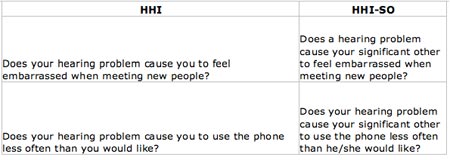
Effectiveness of Group Audiologic Rehabilitation: People with Hearing Loss
Hawkins (2005) reviewed twelve peer-reviewed studies on adult group audiologic rehabilitation and concluded that there were short-term psychosocial benefits of such programs. These benefits may include reduced self-perceived hearing handicap, improved self-perceived quality of life, and improved use of communication strategies.
One of the studies included in the Hawkins (2005) review was by Abrams, Hnath-Chisolm, Guerriro & Ritterman (1992). This deserves special mention as it was the first published study that clearly demonstrated the effectiveness of group audiologic rehabilitation in new hearing aid users. This study evaluated three groups of Veterans Administration (VA) patients who were all candidates for a hearing aid: 1) a Control Group, who received no services; 2) a Hearing Aid Group, who received a hearing aid along with a hearing aid orientation session and a follow-up appointment; and 3) an Audiologic Rehabilitation Group, who received a hearing aid, all hearing aid services, and each member participated in a three session audiologic rehabilitation program. Participants in all three groups had similar degrees of hearing loss and similar HHI scores before any intervention was received. All groups were evaluated using the HHI before services were received and then again after services were received. Table 1 outlines the material used in the audiologic rehabilitation program to demonstrate the type of content typically covered in a group program.
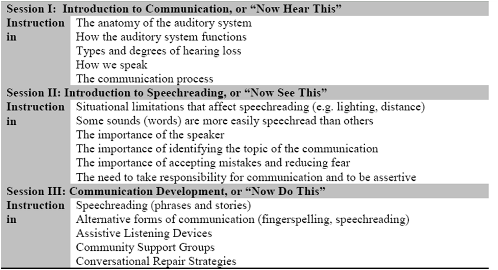
Table 1. Counseling-based audiologic rehabilitation program (From Abrams, Hnath-Chisolm, Guerriro & Ritterman, 1992).
Figure 1 shows the pre-treatment and post-treatment HHI scores for the three subject groups.
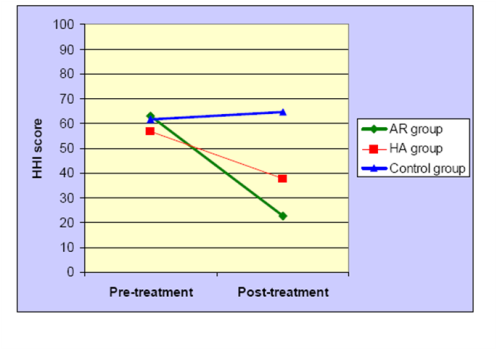
Figure 1. Pre-treatment and post-treatment Hearing Handicap Index scores for the groups: AR (audiologic rehabilitation & hearing aid); HA (hearing aid alone); Control (no treatment). From Abrams, Hnath-Chisolm, Guerriro & Ritterman (1992).
A lower score on the HHI indicates improvement in hearing loss related quality of life. The results of this study show that both the Hearing Aid Group and the Audiologic Rehabilitation Group demonstrated significantly improved hearing loss related quality of life post-treatment, with significantly greater improvements seen in the Audiologic Rehabilitation Group.
Northern and Beyer (1999) demonstrated the value of group audiologic rehabilitation programs in a very practical way. Their study was based on patient data across 73 HEARx centers. In the HEARx program, all new hearing aid users were strongly encouraged to take a three-session group audiologic rehabilitation program. Table 2 shows the content of the program.
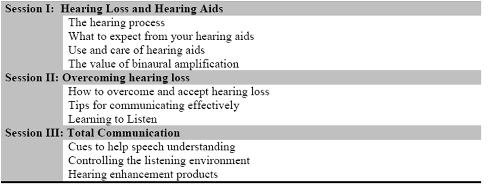
Table 2. HELP (Hearing Education and Listening Program) group audiologic rehabilitation program. From Northern and Beyer (1999).
Northern and Beyer reviewed records from 7,178 patients who purchased hearing aids between January 1 and June 30, 1997, and compared the hearing aid return rate for those that participated in the audiologic rehabilitation classes versus those who did not.
Table 3 shows the results.

Table 3. Hearing aid return rates from patients who purchased hearing aids and completed an audiologic rehabilitation (AR) program compared to patients who purchased hearing aids and did not complete an AR program. From Northern and Beyer (1999).
These results suggest that individuals who complete a group audiologic rehabilitation program are more successful new hearing aid users than those who do not.
Effectiveness of Group Audiologic Rehabilitation: Significant Others
Preminger (2003) attempted to determine whether audiologic rehabilitation class outcomes improved for people with hearing loss if their significant others participated in the classes. Thirteen people with hearing loss participated in traditional group classes without their partners, while 12 people with hearing loss attended classes with their significant others. Each participant attended six, 90-minute classes consisting of informational lectures, training in communication strategies, and speech perception training.
Figure 2 shows the improvement in HHI scores (and HHI-SO scores for the significant others) from pre-treatment to post-treatment. Both groups of people with hearing loss demonstrated significantly improved hearing loss related quality of life following treatment; however, the people with hearing loss who attended with their significant others demonstrated significantly more improvement than those who attended on their own.
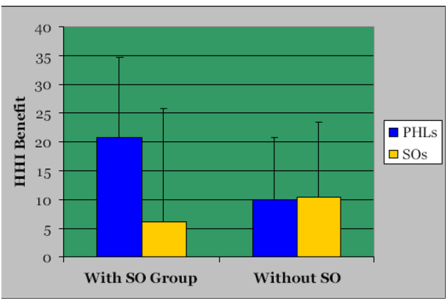
Figure 2. Hearing Handicap Index benefit scores (pre-treatment minus post-treatment): SO = Significant Other; PHL = Person with Hearing Loss. From Preminger (2003).
Recently, I have tried to evaluate the effectiveness of an audiologic rehabilitation program designed specifically for significant others of people with hearing loss. The primary research question I proposed was whether specialized training for spouses improved congruence for hearing loss related quality of life between the spouses and their partners with hearing loss. In this sense, congruence means agreement; in other words, does each member of a couple view the problems associated with hearing loss in the same way?
Two groups of subjects participated in this study. There were 18 "control" couples in which the people with hearing loss participated in a traditional group audiologic rehabilitation class. Additionally, there were 18 "experimental" couples, in which the people with hearing loss took traditional group classes and their spouses participated in a new audiologic rehabilitation program designed for significant others. All classes met for four, 90-minute sessions. Table 4 shows the class content for each type of program.
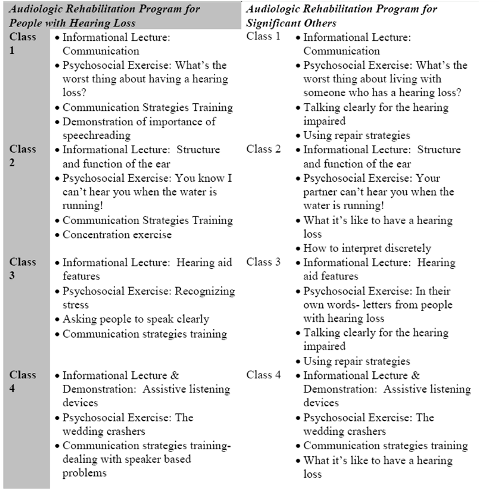
Table 4. Content of two audiologic rehabilitation programs - for people with hearing loss (left column) and for significant others (right column).
Figure 3 is a demonstration of congruence for hearing loss related quality of life among members of a couple. These are the pre-treatment values for all participants. Each point in the figure represents one couple, the HHI-SO scores are represented on the y-axis and the HHI-PHL (person with hearing loss) scores are represented on the x-axis. Couples represented as green circles are congruent, the hearing handicap reported by the person with hearing loss and the hearing handicap perceived by the spouse, are within 14 points. The yellow diamonds represent couples in which the significant other rates the partner's hearing handicap at least 14 points higher than how the person with hearing loss rates him or herself. These are couples in which the person with hearing loss may be minimizing their
problems. The blue squares represent couples in which the person with hearing loss rates his or her own hearing handicap at least 14 points more than how the partner perceives the problem. These are couples in which the spouse may be minimizing the partner's communication problems.
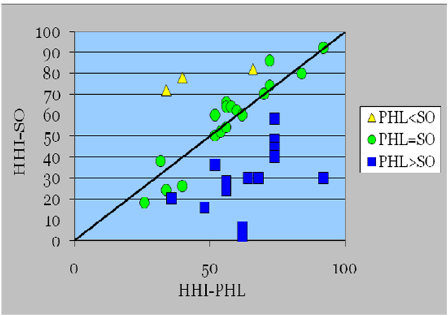
Figure 3. Pre-class HHI-SO scores and HHI-PHL scores for experimental and control couples.
Table 5 shows the distribution of congruence ratings for couples in the control and experimental groups, before and after treatment.

Table 5. Pre-treatment and post treatment congruence findings. Pre-treatment and post treatment congruence findings.
The results show that when the person with hearing loss completes a group audiologic rehabilitation program and the spouse receives no attention (control group) there does not appear to be any effect on the congruence regarding hearing loss related quality of life among the members of a couple. However, in the experimental group, where spouses completed a special rehabilitation program, congruence improved. Pre-treatment only 44% of couples were congruent; post treatment this improved to 72%. Future research will determine if an increase in congruence among couples improves hearing loss related quality of life outcomes.
Implementing an Audiologic Rehabilitation Program in Clinical Practice
Example Activities
The examples of course content presented in Table 1, Table 2 and Table 4 can be used in designing a group audiologic rehabilitation program. At the University of Louisville, we have also found two psychosocial activities to be extremely effective in our group audiologic rehabilitation programs.
The first activity, What's the worst thing about having a hearing loss?, was adapted from Hogan (2001). The purpose of this exercise is to make the group members aware of the difficulties caused by hearing loss. They learn that their problems are typical and to be expected; this helps in dealing with the stigma of hearing loss. Implementation of this exercise is straightforward. The leader asks each member of the group to explain what he or she finds most difficult about hearing loss. The leader writes people's replies for all to see. The leader encourages participants to share the problems associated with their hearing loss as well as the feelings that they associate with these problems. If the replies do not cover all the expected areas, the leader can then ask further questions to better define the difficulties, e.g., "Do you avoid parties? Are you OK staying home rather than going to a party?". Expected responses include difficulty hearing in groups or noise, difficulties in restaurants or at religious services, feelings of frustration and feelings of isolation. Some audiologists may feel intimidated when leading this exercise because they are concerned that they will have difficulty getting participants to share their feelings and problems. From my experience, the opposite is true. Typically, once one participant volunteers a problem the rest join in eagerly. Often I can feel a sense of relief in the room as participants realize that their problems are not unique. One challenge professionals may have when leading this group is keeping quiet. When participants explain their problems and difficulties, the first impulse for professionals is often to try and fix the problems by offering solutions. However, that is not the purpose of this exercise. The aim is for participants to develop a better understanding of the problems that they face as a result of their hearing loss; this is necessary so participants can then begin to use effective communication strategies to deal with these problems.
The second activity, What's the worst thing about living with someone who has a hearing loss?, is for spouses and was adapted from Hogan (2001). It is aimed at making participants aware of the difficulties caused by living with someone who has a hearing loss. Implementation of this exercise is similar to the exercise for people with hearing loss. The leader asks groups members individually to explain what they find most difficult about living with someone who has a hearing loss. The leader writes people's replies for all to see. The leader encourages each participant to share the problems associated with living with a partner who has a hearing loss as well as the feelings associated with these problems. Expected responses include physical issues (e.g. TV too loud, having to repeat), social concerns (e.g. avoiding noisy restaurants, going to movies alone), and emotional reactions such as irritation and frustration. I have found that participants are eager to share their problems and frustrations. When they see that their problems are typical and their frustrations are to be expected, they may become better able to accept these problems and to embrace the need to practice effective communication.
Resources
For further ideas in designing audiologic rehabilitation programs, a list of suggested
materials in provided in Table 6.
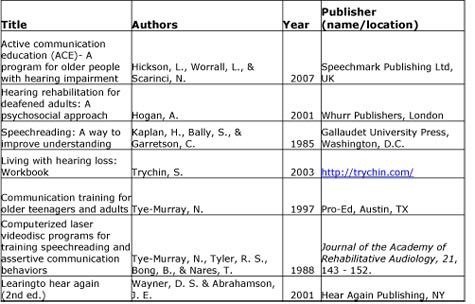
Click Here to View Larger Version of Table 6 (PDF)
Table 6. Resources for designing audiologic rehabilitation programs.
Is it Really Worth It?
While scheduling can be difficult and teaching the classes can be time-consuming, participants in group audiologic rehabilitation typically show benefit after just three class sessions. It is also possible to earn income from these classes. For example, by charging $50 per couple for a series of three, 1-hour sessions, professionals can earn $83/hour when at least 5 couples participate. In addition, these classes can benefit an audiology practice by increasing customer satisfaction and by decreasing the number of returned hearing aids.
References
Abrams, H. B., Hnath-Chisolm, T., Guerreiro, S. M., & Ritterman, S. I. (1992). The effects of intervention strategy on self-perception of hearing handicap. Ear and Hearing, 13, 371-377.
Brooks, D. N., Hallam, R. S., & Mellor, P. A. (2001). The effects on significant others of providing a hearing aid to the hearing-impaired partner. British Journal of Audiology, 35, 165-171.
Carabellese, C., Appollonio, I., Rozzini, R., Bianchetti, A., Frisoni, G. B., Frattola, L. et al. (1993). Sensory impairment and quality of life in a community elderly population. Journal of the American Geriatrics Society, 41, 401-407.
Chisolm, T. H., Johnson, C. E., Danhauer, J. L., Portz, L. J. P., Abrams, H. B., Lesner, S. et al. 2007). A systematic review of health-related quality of life and hearing aids: final report of the American Academy of Audiology task force on the health-related quality of life benefits of amplification in adults. Journal of the American Academy of Audiology, 18, 151-183.
Dalton, D. S., Cruickshanks, K. J., Klein, B. E., Klein, R., Wiley, T. L., & Nondahl, D. M. (2003). The impact of hearing loss on quality of life in older adults. Gerontologist, 43, 661-668.
Duijvestijn, J. A., Anteunis, L. J., Hoek, C. J., Van Den Brink, R. H., Chenault, M. N., & Manni, J. J. (2003). Help-seeking behaviour of hearing-impaired persons aged> or = 55 years; effect of complaints, significant others and hearing aid image. Acta Oto-Laryngologica, 123, 846-850.
Gurland, B., Kuriansky, J., Sharpe, L., Simon, R., Stiller, P., & Birkett, P. (1977). The Comprehensive assessment and Referral Evaluation (CARE)tionale, development and reliability. International Journal of Aging & Human Development, 8, 9-42.
Hawkins, D. B. (2005). Effectiveness of counseling-based adult group aural rehabilitation programs: a systematic review of the evidence. Journal of the American Academy of Audiology, 16, 485-493.
Hetu, R. (1996). The stigma attached to hearing impairment. Scandinavian Audiology, 25, 12-24.
Hetu, R., Jones, L., & Getty, L. (1993). The impact of acquired hearing impairment on intimate relationships: Implications for rehabilitation. Audiology, 32, 363-381.
Hetu, R., Lalonde, M., & Getty, L. (1987). Psychosocial disadvantages associated with occupational hearing loss as experienced in the family. Audiology, 26, 141-152.
Hetu, R., Riverin, L., Lalande, N., Getty, L., & St-Cyr, C. (1988). Qualitative analysis of the handicap associated with occupational hearing loss. British Journal of Audiology, 22, 251-264.
Hickson, L. & Worrall, L. (2003). Beyond hearing aid fitting: improving communication for older adults. International Journal of Audiology, 42, S84-91.
Hickson, L., Worrall, L., & Scarinci, N. (2007). A randomized controlled trial evaluating the active communication education program for older people with hearing impairment. Ear and Hearing, 28, 212-230.
Hogan, A. (2001). Hearing Rehabilitation for Deafened Adults: A psychosocial Approach. London, England: Whurr Publishers.
Kaplan, H., Bally, S., & Garretson, C. (1985). Speechreading: A way to improve understanding. Washington DC: Gallaudet University Press.
Kramer, S. E., Kapteyn, T. S., Kuik, D. J., & Deeg, D. J. (2002). The association of hearing impairment and chronic diseases with psychosocial health status in older age. Journal of Aging and Health, 14, 122-137.
Lormore, K. A. & Stephens, S. D. (1994). Use of the open-ended questionnaire with patients and their significant others. British Journal of Audiology, 28, 81-89.
McArdle, R., Chisolm, T. H., Abrams, H. B., Wilson, R. H., & Doyle, P. J. (2005). The WHO-DAS II: measuring outcomes of hearing aid intervention for adults. Trends in Amplification, 9, 127-143.
Mulrow, C. D., Aguilar, C., Endicott, J. E., Velez, R., Tuley, M. R., Charlip, W. S. et al. (1990). Association between hearing impairment and the quality of life of elderly individuals. Journal of the American Geriatrics Society, 38, 45-50.
Newman, C. W., Jacobson, G. P., Hug, G. A., Weinstein, B. E., & Malinoff, R. F. (1991). Practical method for quantifying hearing aid benefit in older adults. Journal of the American Academy of Audiology, 2, 70-75.
Newman, C. W. & Weinstein, B. E. (1988). The Hearing Handicap Inventory for the Elderly as a measure of hearing aid benefit. Ear and Hearing, 9, 81-85.
Newman, C. W., Weinstein, B. E., Jacobson, G. P., & Hug, G. A. (1990). The Hearing Handicap Inventory for Adults: psychometric adequacy and audiometric correlates. Ear and Hearing, 11, 430-433.
Northern, J. L. & Beyer, C. M. (1999). Reducing hearing aid returns through patient education. Audiology Today, 20, 143-150.
Pichora-Fuller, M. K. & Singh, G. (2006). Effect of age on auditory and cognitive processing: implication for hearing aid fitting and audiologic rehabilitation. Trends in Amplification, 10, 29-59.
Piercy, S. K. & Piercy, F. P. (2002a). Couple dynamics and attributions when one partner has an acquired hearing loss: implications for couple therapy. Journal of Marital & Family Therapy.28(3):315-26.
Piercy, S. K. & Piercy, F. P. (2002b). Couple dynamics and attributions when one partner has an acquired hearing loss: implications for couple therapy. Journal of Marital & Family Therapy.28(3):315-26.
Preminger, J. E. (2003). Should significant others be encouraged to join adult group audiologic rehabilitation classes? Journal of the American Academy of Audiology, 14, 545-555.
Pugh, K. C. & Crandell, C. C. (2002). Hearing loss, hearing handicap, and functional health status between African American and Caucasian American seniors. Journal of the American Academy of Audiology, 13, 493-502.
Revoile, S. G. (1999). Hearing loss and the audibility of phoneme cues. In J.M.Pickett (Ed.), The acoustics of speech communication (pp. 289-323). Boston: Allyn & Bacon.
Scarinci, N., Worrall, L., & Hickson, L. (2008). The effect of hearing impairment in older people on the spouse. International Journal of Audiology, 47, 141-151.
Stark, P. & Hickson, L. (2004). Outcomes of hearing aid fitting for older people with hearing impairment and their significant others. International Journal of Audiology, 43, -398.
Stewart, M., Davidson, K., Meade, D., Hirth, A., & Weld-Viscount, P. (2001). Group support for couples coping with a cardiac condition. Journal of Advanced Nursing, 33, 190-199.
Suls, J., Matin, R., & Wheeler, L. (2002). Social Comparison: Why, with whom and with what effect? Current Directions in Psychological Science, 11, 159-163.
Trychin, S. (2002). Guidelines for Providing Mental Health Services to People who are Hard of Hearing (Rep. No. ED466082). University of California San Diego.
Ventry, I. M. & Weinstein, B. E. (1982). The hearing handicap inventory for the elderly: a new tool. Ear and Hearing, 3, 128-134.
Weinstein, B. E. (2000). Geriatric Audiology. New York: Thieme.


